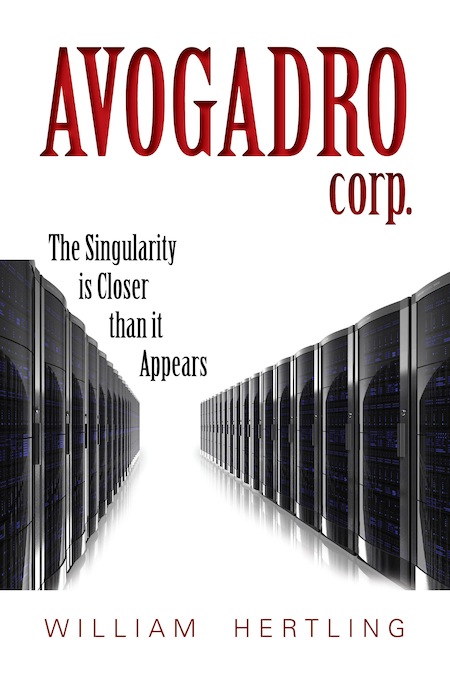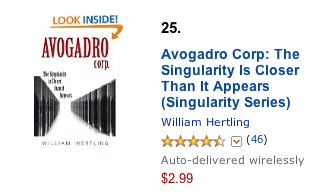Like to read? Me too.
Enter today! For the official rules and the list of great books visit the Kindle Books on Fire website.
Like to read? Me too.
Enter today! For the official rules and the list of great books visit the Kindle Books on Fire website.
Mark Lawrence, author of Prince of Thorns, has created The Million Dollar Bookshop webpage, where he’s selling off pixels to raise money for children’s charities: http://www.themilliondollarbookshop.com/
Donors can have their books listed, which gives them valuable exposure while raising money. Each image links to a the retailer or author page of your choice. I’ve made a donation to Doernbecher Children’s Hospital, and listed A.I. Apocalypse.
Check it out: http://www.themilliondollarbookshop.com/

 When I was about ten, I visited a nightclub for a party of some kind; an aunt or uncle’s birthday, I think. In the hallway into the main room was a large window into another universe. At least, that’s what it looked like to me at age ten.
When I was about ten, I visited a nightclub for a party of some kind; an aunt or uncle’s birthday, I think. In the hallway into the main room was a large window into another universe. At least, that’s what it looked like to me at age ten.
 |
![]()
![]()


I was searching my computer for a file this morning, and found a bunch of images I’d created in the course of writing and publishing Avogadro Corp. You can click on any of the images to see the original, high resolution photos.
It starts with this timeline for Avogadro Corp. I think it’s pretty cool, although the canonical date for the events in Avogadro Corp is now 2015.
I also found one of the pieces of the original cover design. We ended up abandoning this style, but you can see the subtitle “The Singularity Is Closer Than It Appears” comes from this visual:
Here’s the Avogadro corporate structure. This is somewhat inaccurate as compared to what’s in the final book. It also doesn’t quite address one of the lingering continuity errors: Gary Mitchell is the combination of two earlier characters. In the novel he is the head of both Ops and Communication Products.
This is probably my favorite image of the bunch. It’s the location of Avogadro Corp headquarters, located in Portland, Oregon. In real life, this is the site of Conway Trucking.

I’m incredibly excited that the audiobook version of Avogadro Corp is available on Audible.com!
It’s narrated by Rob Granniss of Brick Shop Audio. I’m delighted with how the book came out.
When Avogadro Corp was first published last December, it had a few typos. I released updated versions of the Kindle format, as those mistakes were uncovered and corrected.
But when I got the first audition tape for Avogadro from Rob, it was the first time I’d heard the book read out loud by something else. I quickly realized that I needed to do a lot more than just correct typos: I needed to go through the whole novel with a scouring pad, and clean out my overuse of certain words or sentence structures.
The result was a lengthy reworking of the narrative, with more than two hundred and fifty changes.
The audiobook includes the most up to date text, and the Kindle version has been re-released as well. The paperback in still in progress — print formatting is time consuming and hard — but that will be re-released in a few weeks as well.
I hope you’ll buy a copy of the audiobook for yourself or a friend, and check out the updated Kindle version as well.
The notion of a ‘contained thriller’, that is a story which takes place entirely within a constrained environment, holds tremendous appeal for me because it allows the exploration of ideas, characters and settings without the distractions of the world at large. I find that the tension is further heightened because the environment is limited: Alfred Hitchcock’s Rear Window would be an entirely different movie if our protagonist could simply have gotten up out of his wheelchair and walked over to the neighbor’s apartment.
Such is the case with the novella Brody: Hope Unconquered. Erik Wecks has done a superb job of using a contained environment (a two-person spacecraft on an unstoppable/unchangeable five year journey) to create, hold, and build the tension core to the story. In a time when year-long crewed missions to Mars are under consideration, I think this is a timely exploration of just what it means to live within such an environment.
The other example of a contained environment scifi story is Hugh Howey’s Wool, which I loved and reviewed a few months ago. I found a similar enjoyment in both Wool and Brody in terms of growing to understand the universe at large as well as the limitations of their environments.
Brody has two intertwined threads: the story of the trip through space, and a backstory thread that explores how Roger and Helena came to be on the ship, and the stakes involved for them. This backstory serves to heighten the tension of the forward storyline. The integration of the two is perhaps the one weak point of the book, as I sometimes found myself confused in the backstory thread, but this didn’t interfere with my enjoyment of the book as a whole.
I enjoyed Brody: Hope Unconquered and hope you’ll check it out.
Daniel Suarez, author of Daemon, Freedom, and the recently published Kill Decision, giving a talk at Google, discussing technology and lethal autonomy:
(If you liked Avogadro Corp or A.I. Apocalypse, you’ll love Daniel’s books.)
In my technothriller, A.I. Apocalypse, I wrote about a teenage computer hacker who writes an evolutionary computer virus. Among other things, the virus hunts for bits of useful computer functions in existing legitimate applications, such as a library for copying files, sending data, or encrypting data.
This morning I read about the Frankenstein Virus, which is a real-world virus that does the same thing:
Having infected a computer, it searches the bits and bytes of common software such as Internet Explorer and Notepad for snippets of code called gadgets – short instructions that perform a particular kind of small task.
Previous research has shown that it is theoretically possible, given enough gadgets, to construct any computer program. Mohan and Hamlen set out to show that Frankenstein could build working malware code by having it create two simple algorithms purely from gadgets. “The two test algorithms we chose are simpler than full malware, but they are representative of the sort of core logic that real malware uses to unpack itself,” says Hamlen. “We consider this a strong indication that this could be scaled up to full malware.”
Frankenstein follows pre-written blueprints that specify certain tasks – such as copying pieces of data – and swaps in gadgets capable of performing those tasks. Such swaps repeat each time Frankenstein infects a new computer, but with different gadgets, meaning that the malware always looks different to antivirus software, even if its ultimate effects are the same.
This is a huge leap forward in virus writing, because it makes it substantially more difficult to detect such self-creating viruses:
Existing malware already attempts to randomly mutate its code to some extent, but antivirus software can still recognise them as something nasty.
Frankenstein is different because all of its code, including the blueprints and gadget-finder, can adapt to look like parts of regular software, making it harder to detect.

Both Avogadro Corp and A.I. Apocalypse are in the top 40 best-selling technothrillers this week!
Wow – thank you everyone.